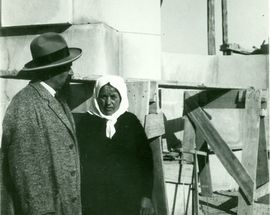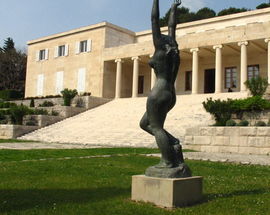When it comes to Croatian art the name Ivan Meštrović towers above all others, a sculptor of grand scope and ambition who straddled the great movements of the twentieth century and left behind monumental works that have helped define the character of the cities in which they are placed. As well as being a figure of global critical acclaim he was also a truly national sculptor, exploring the great themes and folk motifs of his own people. Few artists have captured the different aspects of the Croatian personality quite so well.
Ivan Meštrović was born on August 15 1883 into a family of agricultural labourers. His parents were working in Vrpolje in Slavonia at the time of his birth, but they soon moved back to their home region of Otavice, in the Dalmatian interior, where Meštrović spent his formative years. Apprenticed to a Split stonemason at the age of 16 his skills were soon spotted, and benefactors paid for him to study sculpture at the Fine Art Academy in Vienna.
It was the flamboyant, fluid style of the Viennese Secession that influenced him early on: his sensuous Well of Life (1905), in front of the Croatian National Theatre in Zagreb, is an outstanding example of his early style. He was also a friend of the great French sculptor Rodin, and he spent several years in Paris and other European cities before moving to Zagreb in 1919.
Like most other young artists of his generation, Meštrović saw Yugoslavism as an emancipatory force that would help Croats to forge a new identity separate from the Habsburg Empire, and much of his early work was influenced by these ideals. His work increasingly explored the mythology of the South Slavs, and many of the resulting sculptures were exhibited in the Serbian pavilion at the Rome International Exhibition of 1911. Such was Meštrović’s growing international reputation that he was given a one-man show in the Victoria and Albert Museum in London in 1915: it was a time of war, small nations were fighting against great empires, and Meštrović was seen as a young energetic artist who represented the spirit of the epoch.
After World War I Meštrović was one of the leading artistic personalities of the new Kingdom of Serbs, Croats and Slovenes (later renamed Yugoslavia). He based himself in Zagreb and taught at the Academy of Fine Arts. Widely recognized as the greatest sculptor of his generation, he was much in demand, designing prestige monuments to World War I in Belgrade’s Kalemegdan Park, where his Victor and Monument of Gratitude to France still define the landscape. For the city of Split he made the towering statue of medieval Croatian bishop Gregory of Nin, the unveiling of which in 1929 was one of the great public events of the age. Now situated just outside the Golden Gate (it was originally sited on the Peristyle, a space for which it was just too big), it is a much-loved local landmark whose toes are rubbed for luck as people stroll past the pedestal.
Meštrović had a huge impact on the urban character of Zagreb, where his statue of the nineteenth-century cultural reformer Archbishop Strossmayer was placed behind the Croatian Academy of Arts. His monument to Nikola Tesla, originally in the Ruđer Bošković Institute, now stands on the corner of Preradovićeva and Teslina in the city centre. Meštrović was also the creator of one of the capital’s most swooningly beautiful buildings, the pale grey rotunda housing the headquarters of the HDLU (Croatian Society of Fine Artists) on Trg žrtava fašizma.
Meštrović was viewed with suspicion by the quisling regime that came to power in April 1941, and he spent three months in prison before being forced to emigrate. He was not very enthusiastic about the communist Yugoslavia that came into being after World War II, however, and moved to the USA, where he taught at Syracuse University in New York, and then Notre Dame at South Bend Indiana. He died in 1962, his remains brought back to Otavice where they entered the family mausoleum he had himself designed.
The museum in Meštrović’s former atelier in Zagreb’s Upper Town is currently undergoing renovation, but there are numerous sites around the country where the sculptor’s work can be admired. You can find more information at mestrovic.hr




 - Meštrović Atelier_m.jpg)

_m.jpg)



Comments